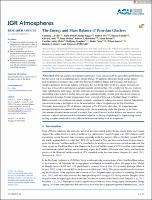Mostrar el registro sencillo del ítem
The Energy and Mass Balance of Peruvian Glaciers
| dc.contributor.author | Fyffe, C.L. | |
| dc.contributor.author | Potter, E. | |
| dc.contributor.author | Fugger, S. | |
| dc.contributor.author | Orr, A. | |
| dc.contributor.author | Fatichi, Simone | |
| dc.contributor.author | Loarte, Edwin | |
| dc.contributor.author | Medina, Katy | |
| dc.contributor.author | Hellström, R.Å. | |
| dc.contributor.author | Bernat, M. | |
| dc.contributor.author | Aubry-Wake, Caroline | |
| dc.contributor.author | Gurgiser, W. | |
| dc.contributor.author | Perry, L. B. | |
| dc.contributor.author | Suarez, Wilson | |
| dc.contributor.author | Quincey, D.J. | |
| dc.contributor.author | Pellicciotti, F. | |
| dc.coverage.spatial | Ancash | |
| dc.coverage.spatial | Cordillera Blanca | |
| dc.coverage.spatial | Cordillera de Vilcanota | |
| dc.date.accessioned | 2021-12-22T17:15:20Z | |
| dc.date.available | 2021-12-22T17:15:20Z | |
| dc.date.issued | 2021-12 | |
| dc.identifier.uri | https://hdl.handle.net/20.500.12542/1603 | |
| dc.description.abstract | Peruvian glaciers are important contributors to dry season runoff for agriculture and hydropower, but they are at risk of disappearing due to climate change. We applied a physically based, energy balance melt model at five on-glacier sites within the Peruvian Cordilleras Blanca and Vilcanota. Net shortwave radiation dominates the energy balance, and despite this flux being higher in the dry season, melt rates are lower due to losses from net longwave radiation and the latent heat flux. The sensible heat flux is a relatively small contributor to melt energy. At three of the sites the wet season snowpack was discontinuous, forming and melting within a daily to weekly timescale, and resulting in highly variable melt rates closely related to precipitation dynamics. Cold air temperatures due to a strong La Niña year at Shallap Glacier (Cordillera Blanca) resulted in a continuous wet season snowpack, significantly reducing wet season ablation. Sublimation was most important at the highest site in the accumulation zone of the Quelccaya Ice Cap (Cordillera Vilcanota), accounting for 81% of ablation, compared to 2%–4% for the other sites. Air temperature and precipitation inputs were perturbed to investigate the climate sensitivity of the five glaciers. At the lower sites warmer air temperatures resulted in a switch from snowfall to rain, so that ablation was increased via the decrease in albedo and increase in net shortwave radiation. At the top of Quelccaya Ice Cap warming caused melting to replace sublimation so that ablation increased nonlinearly with air temperature. | es_PE |
| dc.format | application/pdf | es_PE |
| dc.language.iso | eng | es_PE |
| dc.publisher | John Wiley & Sons | es_PE |
| dc.relation.ispartof | urn:issn: 2169897X | |
| dc.relation.uri | https://doi.org/10.1029/2021JD034911 | es_PE |
| dc.rights | info:eu-repo/semantics/openAccess | es_PE |
| dc.rights | Atribución-NoComercial-SinDerivadas 3.0 Estados Unidos de América | * |
| dc.rights.uri | http://creativecommons.org/licenses/by-nc-nd/3.0/us/ | * |
| dc.source | Repositorio Institucional - SENAMHI | es_PE |
| dc.source | Servicio Nacional de Meteorología e Hidrología del Perú | es_PE |
| dc.subject | Glaciares | es_PE |
| dc.subject | Cambio Climático | es_PE |
| dc.subject | Energy Balance | es_PE |
| dc.subject | Glacier Dynamics | es_PE |
| dc.subject | Shallap Glacier | es_PE |
| dc.subject | Longwave Radiation | es_PE |
| dc.subject | Sensible Heat Flux | es_PE |
| dc.title | The Energy and Mass Balance of Peruvian Glaciers | es_PE |
| dc.type | info:eu-repo/semantics/article | es_PE |
| dc.identifier.isni | 0000 0001 0746 0446 | |
| dc.description.peerreview | Por pares | |
| dc.identifier.journal | Journal of Geophysical Research: Atmospheres | |
| dc.subject.ocde | https://purl.org/pe-repo/ocde/ford#1.05.11 | es_PE |
| dc.publisher.country | PE | es_PE |
| dc.subject.sinia | variabilidad climatica - Clima y Eventos Naturales | |
| dc.type.sinia | text/publicacion cientifica | |
| dc.identifier.url | https://hdl.handle.net/20.500.12542/1603 |
Ficheros en el ítem
Este ítem aparece en la(s) siguiente(s) colección(es)
-
Artículo científico [171]









